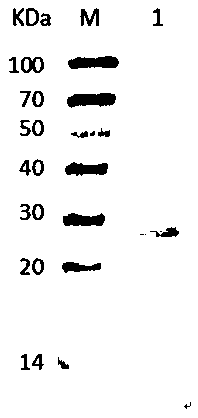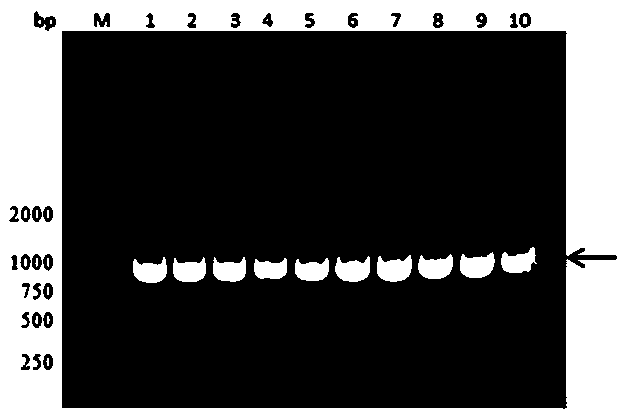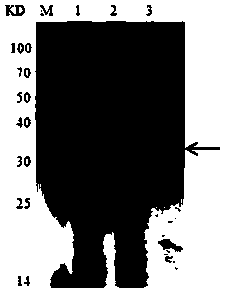Shuttling intracellular antibody TAT-4F for H3N2-type canine influenza virus
A technology of TAT-4F and canine influenza virus, applied in the direction of antibodies, antiviral agents, recombinant DNA technology, etc., can solve the problem of weak immune cross-reaction
- Summary
- Abstract
- Description
- Claims
- Application Information
AI Technical Summary
Problems solved by technology
Method used
Image
Examples
Embodiment 1
[0023] Example 1: Construction and expression of M1 recombinant expression plasmid pET-SUMO-M1 and purification of M1 protein
[0024] Design and synthesize primers M1P1 and M1P2, use canine H3N2 cDNA as a template to PCR amplify the M1 protein gene, and clone it into the PET-SUMO vector to construct the plasmid pET-SUMO-M1, and then transfer it into T-shot competent cells containing kan Resistant agar plates were used for preliminary screening. A single colony was selected and cultured in LB liquid medium; the plasmid was extracted with a plasmid recovery kit, identified by PCR, and the product was analyzed by 1% agarose gel electrophoresis, and a band of about 750 bp was obtained, which was consistent with the inserted target gene. The sequence was determined to prove that the target fragment was correctly inserted into the vector, and the recombinant plasmid pET-SUMO-M1 was successfully constructed.
[0025] The recombinant plasmid pET-SUMO-M1 was transformed into the expr...
Embodiment 2
[0027] Example 2: Amplification of phage single-chain antibody library
[0028] 1. Construction of canine phage antibody library construction
[0029] Separation of canine lymphocytes: Separation of 6 peripheral blood lymphocytes of Beagle dogs, extraction of total RNA, reverse transcription to synthesize cDNA; amplification of VH gene, adding NcoI and XhoI restriction sites to the upstream and downstream respectively; amplification of VL gene, upper , and downstream respectively add SalI and NotI enzyme cutting sites; VH enzyme digestion and ligation into the PIT2 vector; VL enzyme digestion and ligation into the PIT2 vector.
[0030] 2. The constructed vector was electrotransformed into Escherichia coli TG1, coated on a TYE plate (containing a final concentration of 100 μg / mL Amp + 1% glucose), cultured overnight at 37°C, and a single clone was randomly picked from the plate for bacterial liquid PCR identification, and calculated Recombination rate, and estimated storage ca...
Embodiment 3
[0031] Example 3: Screening of anti-M1-scFv
[0032] The purified M1 protein was antigen-coated on a 96-well microtiter plate and kept overnight at 4°C. Discard the supernatant the next day, block with 2% Milk-PBS at 37°C for 2 hours, and add the prepared phage antibody library (titer: 1.0×10 13 pfu), shake vigorously at room temperature for 60 minutes, and let stand for 60 minutes. Discard the liquid, wash 10 times with PBS containing 0.1% Twenn-20, pat dry the remaining liquid in each well after washing, add 50 µL eluent (5 mg / mL trypsin-PBS) to each well, Vigorously shake at room temperature for 10 min to elute the phage, collect and store at 4°C.
[0033] Infect E.coli TG1 with the eluted phage, spread on TYE plates (containing 100μg / mL Amp and 1% glucose) and culture overnight at 37°C. The phage library was amplified using the helper phage KM13, and the phage were recovered by PEG / NaCl. Repeat the above process 3 times, a total of 4 rounds of screening.
[0034] Phag...
PUM
 Login to View More
Login to View More Abstract
Description
Claims
Application Information
 Login to View More
Login to View More - R&D
- Intellectual Property
- Life Sciences
- Materials
- Tech Scout
- Unparalleled Data Quality
- Higher Quality Content
- 60% Fewer Hallucinations
Browse by: Latest US Patents, China's latest patents, Technical Efficacy Thesaurus, Application Domain, Technology Topic, Popular Technical Reports.
© 2025 PatSnap. All rights reserved.Legal|Privacy policy|Modern Slavery Act Transparency Statement|Sitemap|About US| Contact US: help@patsnap.com



